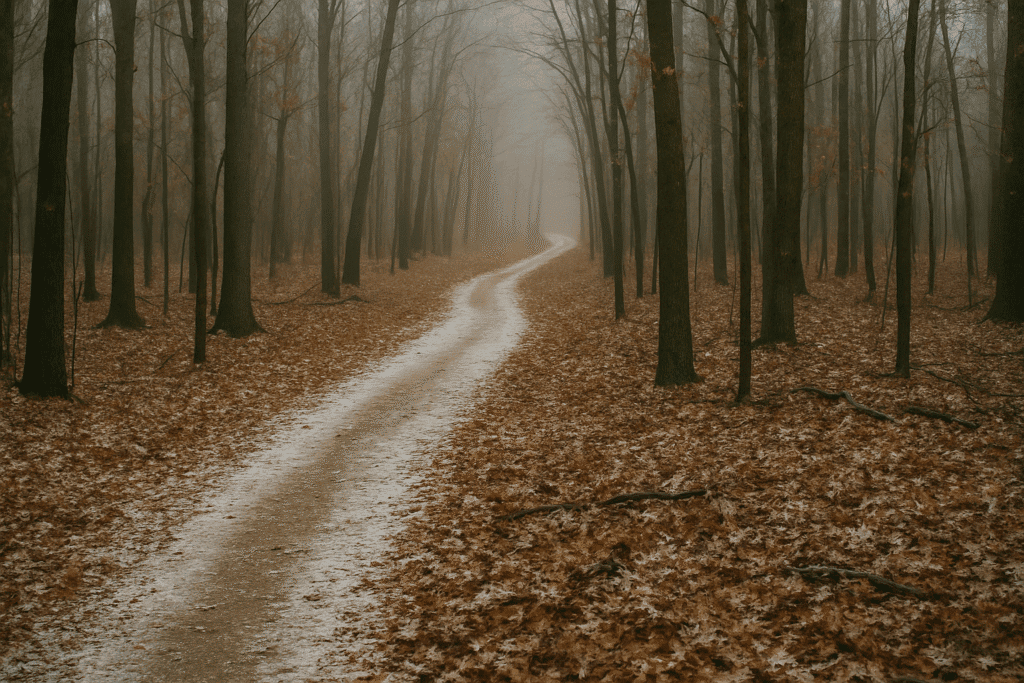❄️ Hiking the Ice Age Trail in November: A Frosty Walk Through Time
By Sasha – Winter Camping Expert @ HikerHeritage.com
There’s something strangely comforting about cold. I know, that probably sounds ridiculous. But when the leaves are long gone, the trails are empty, and the first frost clings to every branch like a stubborn memory — that’s when I feel most at home. This past November, I solo-hiked a section of the Ice Age National Scenic Trail through the Kettle Moraine State Forest in Wisconsin. It wasn’t the longest hike I’ve done, but it was one of the most meaningful.
Why the Ice Age Trail?
If you’ve never heard of it, the Ice Age Trail is one of 11 National Scenic Trails in the U.S., stretching over 1,200 miles across Wisconsin. What makes it special is how it follows the edge of the last continental glacier — that’s right, you’re literally walking through ancient geological history: moraines, kettles, eskers — all the scars left behind by the retreating ice sheet 12,000 years ago.
I picked the Southern Kettle Moraine segment near LaGrange, mostly because I’d heard it was beautiful and challenging in shoulder season. I wasn’t disappointed.
The First Few Miles: Frost, Fog & Silence
I started my hike just after sunrise. The trailhead was empty, which is a cold-weather perk I’ll never stop appreciating. My breath puffed out in silver clouds, my fingers already tucked deep inside my GORE-TEX winter mitts, and my microspikes were strapped to my pack in case the trail turned icy.
Almost immediately, I was swallowed by silence — that kind of hush that only exists when the forest is still holding its breath. The leaves underfoot were crunchy with frost, and every pine needle sparkled like it had been hand-dipped in glass.
There’s no playlist or podcast in the world that can top that sound: boots on frozen trail, chickadees chirping distantly, and the faint whistle of wind weaving through naked trees.
What I Carried (And Why It Mattered)
If you know me, you know I don’t mess around when it comes to gear. This trip wasn’t about testing the latest ultralight sleeping pad or titanium stove — it was about staying warm, dry, and alive.
Here’s a quick rundown of what I brought:
- Sleeping system: -10°F down mummy bag with a thermal liner
- Shelter: Single-wall, 4-season tent with snow skirt
- Clothing: Wool base layers, fleece mid, windproof insulated outer, and my trusty balaclava
- Stove: Liquid fuel — because canister stoves lose efficiency in the cold
- Snacks: Peanut butter, cheese, instant mashed potatoes, and hot cocoa. Always cocoa.
I packed for winter, even though the forecast said "lows in the 30s." Wisconsin weather doesn’t care about forecasts. And sure enough, that night, it dipped to 21°F.
The Moment That Hit Me
Midway through the hike, just as the trail curved along a ridge above a kettle lake, the sun broke through the clouds. The light hit the water just right — golden rays cutting through morning mist like a blade through ice.
I stopped. Dropped my pack. Sat on a lichen-covered rock. And cried.
Not because I was cold. Not because I was tired. But because I realized this moment would be forgotten by the world if I didn’t bear witness. That trail, that silence, that stillness — it deserved to be remembered.
And that’s why I hike in the cold.
Lessons from the Trail (That You Won’t Find in a Guidebook)
- You’ll never regret overpacking insulation. Shivering at 3 a.m. in a sleeping bag that’s “rated for 30°F” is a mistake you’ll only make once.
- Solo hiking builds resilience. There’s no one else to check the map, boil the water, or filter the stream. You become both the guide and the follower.
- Snow makes you listen. Every crunch under your boots is a reminder: You are here. And here is all you need.
Final Camp: Stars, Fire, and Frozen Socks
My last night was spent tucked into a pine grove, the wind mostly blocked, the stars shockingly bright. I strung my socks over a guyline, knowing they’d be stiff as boards by morning. But I didn’t care. I had a fire, a full belly, and the comforting ache of muscles used well.
Lying in my tent that night, I thought about glaciers — how they moved slowly, but reshaped everything in their path. Maybe that’s what cold-weather hiking does to a person. Maybe it’s not just about braving the elements.
Maybe it’s about becoming something stronger in the process.
Thinking of Hiking the Ice Age Trail in Shoulder Season? Here's My Advice
- Layer smart: Start cold and warm up while moving. Avoid sweating — wet clothes in cold temps can be dangerous.
- Know your exits: Some sections are remote. Download offline maps and check trail conditions before you go.
- Bring backup fire starters: Waterproof matches, a ferro rod, and some dryer lint in a ziplock bag go a long way.
- Embrace the quiet: Don’t fill it with noise. Let the trail speak.
In Summary...
If you’ve ever wondered what it’s like to hike when the crowds are gone, the bugs are dead, and the world seems like it’s waiting for something — go in November. Go when it’s cold. Go when you don’t feel ready.
The Ice Age Trail in late fall isn’t just a hike — it’s a meditation. A conversation between you and the Earth that’s been 12,000 years in the making.
Thanks for walking with me,
— Sasha ❄️
